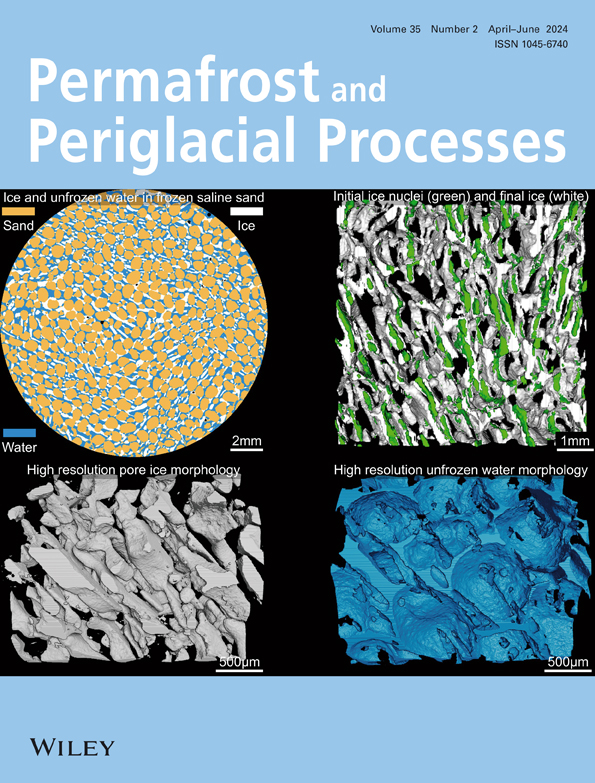生态系统和干扰对近地表冻土分布的影响,Whatì,西北地区,加拿大
IF 3.3
3区 地球科学
Q2 GEOGRAPHY, PHYSICAL
引用次数: 0
摘要
对于处于不连续永久冻土带的偏远社区来说,获取永久冻土带分布图进行危害评估是有限的,而更一般的产品往往不足以用于当地规模的规划。在这项研究中,我们应用已建立的分析方法来说明在加拿大西北地区Whatì社区进行社区尺度永久冻土测绘的时间和成本效益方法。我们使用现场数据、数字地表模型衍生变量和遥感产品进行了二元逻辑回归(BLR)。自变量包括植被、地形位置指数和高程带。因变量来源于139次近地表永久冻土存在/缺失的物理检查,这些物理检查是在可变的北方湿地环境中采样的。在回归中,植被是近地表永久冻土的最强预测因子。该回归预测50.0%(最小置信度为36%)的植被被近地表多年冻土覆盖,空间精度为72.8%。对各种燃烧和未燃烧环境记录的数据分析表明,最近的燃烧情景显著影响了该社区近地表永久冻土的分布。一项空间燃烧分析预测,在不考虑气候变化影响的最大燃烧情景下,近地表永久冻土覆盖将减少18.3%。该研究强调了在气温几乎均匀的生态系统中,生态系统结构和扰动历史驱动永久冻土分布和进化的短期变化的潜力。因此,在社区层面上,这些因素应该像气候变化一样受到重视。本文章由计算机程序翻译,如有差异,请以英文原文为准。
Influence of ecosystem and disturbance on near‐surface permafrost distribution, Whatì, Northwest Territories, Canada
For remote communities in the discontinuous permafrost zone, access to permafrost distribution maps for hazard assessment is limited and more general products are often inadequate for use in local‐scale planning. In this study we apply established analytical methods to illustrate a time‐ and cost‐efficient method for conducting community‐scale permafrost mapping in the community of Whatì, Northwest Territories, Canada. We ran a binary logistic regression (BLR) using a combination of field data, digital surface model‐derived variables, and remotely sensed products. Independent variables included vegetation, topographic position index, and elevation bands. The dependent variable was sourced from 139 physical checks of near‐surface permafrost presence/absence sampled across the variable boreal–wetland environment. Vegetation is the strongest predictor of near‐surface permafrost in the regression. The regression predicts that 50.0% (minimum confidence: 36%) of the vegetated area is underlain by near‐surface permafrost with a spatial accuracy of 72.8%. Analysis of data recorded across various burnt and not‐burnt environments indicated that recent burn scenarios have significantly influenced the distribution of near‐surface permafrost in the community. A spatial burn analysis predicted up to an 18.3% reduction in near‐surface permafrost coverage, in a maximum burn scenario without factoring in the influence of climate change. The study highlights the potential that in an ecosystem with virtually homogeneous air temperature, ecosystem structure and disturbance history drive short‐term changes in permafrost distribution and evolution. Thus, at the community level these factors should be considered as seriously as changes to air temperature as climate changes.
求助全文
通过发布文献求助,成功后即可免费获取论文全文。
去求助
来源期刊
CiteScore
9.70
自引率
8.00%
发文量
43
审稿时长
>12 weeks
期刊介绍:
Permafrost and Periglacial Processes is an international journal dedicated to the rapid publication of scientific and technical papers concerned with earth surface cryogenic processes, landforms and sediments present in a variety of (Sub) Arctic, Antarctic and High Mountain environments. It provides an efficient vehicle of communication amongst those with an interest in the cold, non-glacial geosciences. The focus is on (1) original research based on geomorphological, hydrological, sedimentological, geotechnical and engineering aspects of these areas and (2) original research carried out upon relict features where the objective has been to reconstruct the nature of the processes and/or palaeoenvironments which gave rise to these features, as opposed to purely stratigraphical considerations. The journal also publishes short communications, reviews, discussions and book reviews. The high scientific standard, interdisciplinary character and worldwide representation of PPP are maintained by regional editorial support and a rigorous refereeing system.

 求助内容:
求助内容: 应助结果提醒方式:
应助结果提醒方式:


